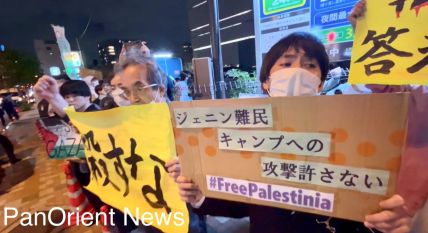|
|
Environment
Serious Marine Radiation Contamination Found off Fukushima: Greenpeace
Thursday, May 26, 2011

Tokyo- (PanOrient News) Greenpeace today slammed the Japanese authorities’"continued inadequate response" to the Fukushima nuclear crisis, after new data from its radiation monitoring showed seaweed radiation levels 50 times higher than official limits, raising serious concerns about continued long-term risks to people and the environment from contaminated seawater.
In a statement issued today, Greenpeace said that earlier this month, its radiation monitoring teams on shore, and on board the international environmental organisation’s flagship Rainbow Warrior, collected samples of marine life including fish, shellfish and seaweed outside Japan’s 12-mile territorial waters and along the Fukushima coast. Detailed analysis by accredited laboratories in France (ACRO) and Belgium (SCK CEN) found high levels of radioactive iodine contamination and significantly high levels of radioactive caesium in the samples.
In contrast, Japanese authorities claim that radioactivity is being dispersed or diluted and are undertaking only limited marine radiation monitoring. Path of radioactive water leak at Japan plant unclear, and “radioactivity is quickly diluted in the ocean, and the dump should not affect the safety of seafood in the area,” according to the Japanese government.
“Our data show that significant amounts of contamination continue to spread over great distances from the Fukushima nuclear plant”, said Jan Vande Putte, Greenpeace Radiation Expert. “Despite what the authorities are claiming, radioactive hazards are not decreasing through dilution or dispersion of materials, but the radioactivity is instead accumulating in marine life. The concentration of radioactive iodine we found in seaweed is particularly concerning, as it tells us how far contamination is spreading along the coast, and because several species of seaweed are widely eaten in Japan.
“Japan’s government is mistaken in assuming that an absence of data means there is no problem. This complacency must end now, and instead mount a comprehensive and continuous monitoring program of the marine environment along the Fukushima coast, along with full disclosure of all information about both past and ongoing releases of contaminated water.”
Most fish and shellfish sampled by Greenpeace were found to contain levels of radioactivity above legal limits for food contamination. This is just one of the multiple, chronic sources of radiation exposure to people living in the greater Fukushima area. In April, the authorities raised regulatory limits for levels of radiation exposure twentyfold to 20 milliSievert per year for all people – including children.
Greenpeace has criticised this controversial revision of regulatory standards, saying it only accounts for sources of external exposure - radioactive materials can also be ingested, inhaled or absorbed through the skin. Any increased exposure consequently also increases the risk of developing cancer and other radiation-related illnesses, it said.
“Ongoing contamination from the Fukushima crisis means fishermen could be at additional risk from handling fishing nets that have come in contact with radioactive sediment (6), hemp materials such as rope, which absorb radioactive materials, and as our research shows, radioactivity in fish and seaweed collected along Fukushima’s coast,” said Wakao Hanaoka, Greenpeace Japan Oceans Campaigner. “Fishermen, their communities and consumers desperately need information on how radioactivity affects their lives, livelihoods and the ecosystems they rely on, and especially how they can protect themselves and their families from further contamination.”
For example, eating one kilo of highly contaminated seaweed sampled by Greenpeace could increase the radiation dose by 2.8 milliSievert – almost three times the internationally recommended annual maximum, according to the statement.
“Even if all the leaks caused by the Fukushima nuclear crisis were to stop today, the radiation problem is not going to go away. A long-term, comprehensive monitoring programme must be put in place, decisive action taken to protect the health of fisherman, farmers and consumers, and compensation given to all whose lives have been destroyed by this disaster,” said Hanaoka.
PanOrient News
© PanOrient News All Rights Reserved.
|
|

